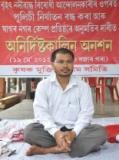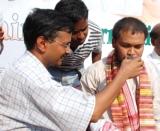Archives
When ENERGY emerges as a popular movement issue
Welcoming a delegation from north east India comprising Arunachal Chief Minister at her government residence Ganabhawan on May 31st, the Bangladesh premier expressed her interest either to import electricity from Arunachal Pradesh or to engage in joint ventures for hydropower there to make up their power deficit (around 1500 mega watts per day).
Arunachal Pradesh, bordering Tibet (China) in the north, has an estimated hydro power potential of more than 60,000 mega watts. The present installed capacity of hydropower projects in the thinly populated state is 423 mega watts.
The energy starved Union government has already initiated the construction of over 160 dams on various rivers of the state. Among those the 2000 mega watts lower Subansiri hydro-electricity project at the Lakhimpur region in the Assam-Arunachal border area is in an advanced stage as the NHPC Ltd, formerly known as the National Hydroelectric Power Corporation, has already completed 75% of its construction.
| The Assam Chief Minister Traun Gogoi insisted that the work on dams including the lower Subansiri project would go on irrespective of protests. He even ruled out any dialogue with Akhil during his hunger strike, terming it as ‘anti-development’. |
The opposition to larger river dams was first rigorously raised by various organizations in Assam and then it spread to the neighboring state of Arunachal Pradesh. Even the Chief Minister Tuki, after returning from Bangladesh, faced strong public resentment against dams in the Himalayan foot-hills state. Various Siang valley based organizations had urged Chief Minister Tuki to scrap the 2700 mega watts lower Siang hydroelectric project.
In a memorandum sent to the state government chief in the first week of June, a number of organizations including Adi Students’ Union, Siang Peoples Forum, Nyiko Bachao Forum, Dam Affected People of Sirit-Siyom Banggo, Yamne-Duyon Banggo Students Union etc asserted that the rivers are the lifeline of indigenous people and hence any intervention to rivers that may create ecological imbalances in the bio-diversity rich state would not be tolerated.
Meanwhile, Assam witnessed a series of massive public demonstrations against river dams along the Brahmaputra, most of them located in Arunachal Pradesh. A nine day hunger strike by the popular anti-mega-dam activist Akhil Gogoi in Guwahati garnered huge public supports. Akhil, a member of Anna Hazare’s core team, started his indefinite hunger strike on May 19th at Lakhidhar Bora Kshetra of the city demanding an immediate halt in the construction of all mega dams of the region.
The General Secretary of Krishak Mukti Sangram Samity, a peasants’ body, was shifted to Guwahati Medical College Hospital on May 25th by the authorities as his health deteriorated. He maintained his fast in the hospital bed till May 28th but finally Akhil broke his fast following the request of anti-corruption crusader Anna Hazare.
While meeting Akhil in the hospital bed, visiting Team Anna member Arbind Kejriwal arranged a telephonic conversation between them, where Anna Hazare argued that Akhil’s health was more important for the anti-dam movement across the country.
 Kejriwal also addressed a huge public rally in the city, where he slammed both the Assam and Arunachal Pradesh governments for their anti-people attitude while licensing the big dam lobbies to exploit the hydroelectricity potential without accountability. The outspoken social activist also condemned the Union Government for its insensitive approach to various issues related to the livelihood of millions of indigenous people in the country.
Kejriwal also addressed a huge public rally in the city, where he slammed both the Assam and Arunachal Pradesh governments for their anti-people attitude while licensing the big dam lobbies to exploit the hydroelectricity potential without accountability. The outspoken social activist also condemned the Union Government for its insensitive approach to various issues related to the livelihood of millions of indigenous people in the country.
Kejriwal clarified that he is not against river dams. However, these projects must not be at the cost of the local people, environment and ecology of any region. He argues that the geo-seismic situation, fragile erosion-prone mountains of the eastern Himalayas and its silt-laden rivers should be taken into consideration before going for all these mega hydroelectric projects. So the government must not impose their decisions on such projects without peoples’ participation and consent.
Earlier, Akhil received support from National Alliance of People’s Movements (NAPM) with 20 other local organisations. NAPM in a statement said that ‘KMSS and Akhil’s brave struggle for life with dignity and against unjust destructive capitalist development thrust upon people against their will’ was a noble venture.
The statement signed by eminent personalities like Sandeep Pandey, Prafulla Samantara, Gabriele Dietrich, Sister Celia, Vimal Bhai, Gautam Bandopadhyay, Mukta Srivastava, Rajendra Ravi etc said, “NAPM supports all demands raised by KMSS including halting the construction of all mega dams till an agreement is formalized with the people living in the downstream, releasing all the detained activists unconditionally and also allowing the protesters to pursue their democratic agitations.”
 Besides KMSS, the activists belonging to All Assam Students’ Union, Asom Jatiyatabadi Yuba Chatra Parishad with a number of ethnic organisations continued their agitation against the big dam lobbies. The activists even prevented the NHPC from carrying construction materials to the lower Subansiri project site since December 26th, 2011.
Besides KMSS, the activists belonging to All Assam Students’ Union, Asom Jatiyatabadi Yuba Chatra Parishad with a number of ethnic organisations continued their agitation against the big dam lobbies. The activists even prevented the NHPC from carrying construction materials to the lower Subansiri project site since December 26th, 2011.
They were unanimous in the view that the indigenous people of the region must have the right on natural resources including the rivers. But the government wants to exploit the resource for its selfish interest and sell the resources to big companies without any realistic consultations with the people.
The Assam Chief Minister Traun Gogoi insisted that the work on dams including the lower Subansiri project would go on irrespective of protests. He even ruled out any dialogue with Akhil during his hunger strike, terming it as ‘anti-development’. Gogoi also viewed that Akhil has every right to opt for democratic protest as every citizen enjoys that liberty in India.
In the meantime, a seminar on energy issues was organized in Itanagar on May 25th where most of the speakers advocated generating power from various sources including hydroelectricity. Inaugurating the seminar an Arunachali bureaucrat-turned-politician even tried to denounce the strong public resentment surfacing in Assam against the big dams planned and proposed in Arunachal Pradesh because of the downstream impact.
T Norbu Thongdok, Parliamentary Secretary to Arunachal Pradesh PWD, while delivering the inaugural address of the seminar organized by Indian Chamber of Commerce in association with Arunachal Pradesh Energy Development Agency and North Eastern Electric Power Corporation Limited, argued that ‘the dams for producing hydro-power are constructed using the best of scientific technology to maximize power production and minimize its hypothetical negative impact that is being spread throughout the state and neighbouring Assam’.
| The protesters in Assam have however accepted the lower Subansiri project at Gerukamukh as a model case study and they have continued raising voices against it democratically. Since the project was taken over by the NHPC Ltd in May 2000, the history of protest and demonstrations began. |
Thongdok stated that power is the most important contributing factor of a developed state so to be efficient we should explore all possible avenues to produce power. Since the deposits of fossil fuels (coal, gas and oil) are being depleted alarmingly, we should conserve energy by making optimum use of it for the future of our nation, asserted the former Power Secretary. He also added that harnessing solar, hydro and wind energy, which are not only clean but also renewable and cheap is the best option to be adopted.
The protesters in Assam have however accepted the lower Subansiri project at Gerukamukh as a model case study and they have continued raising voices against it democratically. Since the project was taken over by the NHPC Ltd in May 2000, the history of protest and demonstrations began. The issue was also discussed many times in the State Legislative Assembly.
 Moreover, the then Union environment minister Jairam Ramesh also attended a public hearing on the big dam issue in Guwahati on September 10th, 2010. The ‘activist minister’ even reportedly wrote to the Prime Minister Dr. Manmohan Singh arguing that ‘some of the concerns that were expressed (by the people) can not be dismissed lightly.’
Moreover, the then Union environment minister Jairam Ramesh also attended a public hearing on the big dam issue in Guwahati on September 10th, 2010. The ‘activist minister’ even reportedly wrote to the Prime Minister Dr. Manmohan Singh arguing that ‘some of the concerns that were expressed (by the people) can not be dismissed lightly.’
Even the Assam Governor JB Patnaik did not forget to mention the big dam issues in his last Republic Day (January 26, 2012) speech at Guwahati. The Governor emphasized on the state government’s commitment to address the people’s apprehensions about the safety of the lower Subansiri project.
“Regarding the lower Subansiri dam, it is the state government’s solemn commitment to ensure that all apprehensions are effectively addressed and all possible steps taken to ensure that people living in the downstream areas are not affected in any way,” he said.
There is no denying the fact that the ongoing resistance to larger river dams has turned into a popular movement in Assam. The activists and their sympathizers have maintained a strong voice of protest and are unanimous in their view that the proposed mega hydro-electricity projects in Assam and Arunachal Pradesh would leave a devastating impact on the region and also in Bangladesh as several large hydropower projects were granted green clearance without prior downstream impact assessment by the Union environment ministry in New Delhi.

